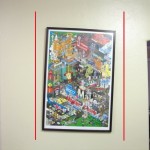No problem can withstand the assault of sustained thinking. – Voltaire

After centuries of dreaming, it only took four years of testing, a background in tinkering, the invention of the internal combustion engine and a basic understanding of aerodynamics to turn manned flight from a fantasy to reality.
What does that mean?
The preeminent trait of humankind is our ability to think. Yes, some other creatures can do some basic problem solving, but humans are still the best at it. It’s what got us organized, took us from sharpened sticks to missiles, from scrounging for food, to grocery stores full of food.
The quote says that if you keep thinking, you will figure out. Nothing is impossible, it’s just a matter of how long it will take to come up with the solution. It took us until just over 100 years ago to figure out how to fly. It took until just over 40 years ago to go to the moon. Whatever the challenge, we’ll figure it out eventually.
Why is thinking important?
Thinking seems to be the primary activity of all humans. Whether it’s day dreaming, plotting, scheming, investigating, probing, considering or philosophising, we’re busy thinking. Even something as simple as watching TV can cause a serious amount of thinking, especially if you’re watching a show with some technical content, or one where they are solving a mystery.
Thinking is the first step in solving our problems. It starts with observing the situation, thinking to determine what will be useful and what will be detrimental to the attaining the goal. The we do some more thinking and come up with a plan. Then we do what we can, observe the results and think about how to improve the plan. Thinking non-stop. That’s how we roll.
Where can I apply this in my life?
Thinking is a key component in solving problems, and that’s what this quote is all about. What problems do you have in your life, either personal or at work, that need solving? Do you have a plan? Do you even know exactly what the problem is? That might be a good place to start.
It starts with analyzing the problem. This is a step often skipped or skimpped on, and the results can be anything from silly to tragic, depending on what was being done and how bad the misunderstanding was. If you didn’t know how far away the moon was, how would you know how much fuel you needed, or how much food, water and oxygen the crew would use?
Once you have a good grip on the problem and it’s implications, it’s time to take inventory of of what your resources and noticing all the obstacles. While we aren’t quite talking MacGyver here, the basic idea is the same. What you have access to, and what you don’t have, will often determine which avenues can and cannot be pursued.
Years ago, there used to be a show called Junkyard Wars, where a problem was given, and the contestants (in two teams) scrounged for what they could find. If, as an example, you found a big engine, you had more power, but more weight. If you found a little engine, you got less power, but it weighed less. The teams would have to take these details into consideration, and often resulted in design modifications.
Now that you have your resources listed, what are the obstacles? Are there any problems in the immediate area? Building a tower under a tree could pose a problem. Building something large indoors will be a problem, unless you have a door of sufficiently large size. If there is a lot of wood or other combustibles around, you will need to be extra careful when using any open flames or sparks, right?
Now that you know what your problem is, what resources you have, and what obstacles will limit your flexibility, it’s time to start planning. Brainstorm some ideas and use your imagination! Then do a sanity check on each idea to see if it has any chance of working, and test the surviving ideas against each other. Best idea wins, at least for now.
Planning, to me, is just a matter of breaking the problem down into smaller and smaller chunks, until you know how to do any give chunk, or know that you have to find someone who does, or find someone who can teach you how to do it yourself.
The final two steps are to take action, and observe the results. The information goes back into a revised plan and you iterate until you are done. Or your descendants are done. Some of these problems take a little time…
Now, this method is probably best reserved for big projects, and is probably overkill for putting together a holiday meal, right? Unless, that is, you’re serving a feast for a few hundred of your closest friends, most of whom have food allergies; then it might just about be perfect.
From: Twitter, @tonyrobbins
confirmed at : http://www.brainyquote.com/quotes/quotes/v/voltaire161904.html
Photo by “G” jewels g is for grandma







Pingback: The victorious strategist only seeks battle after the victory has been won. | philosiblog